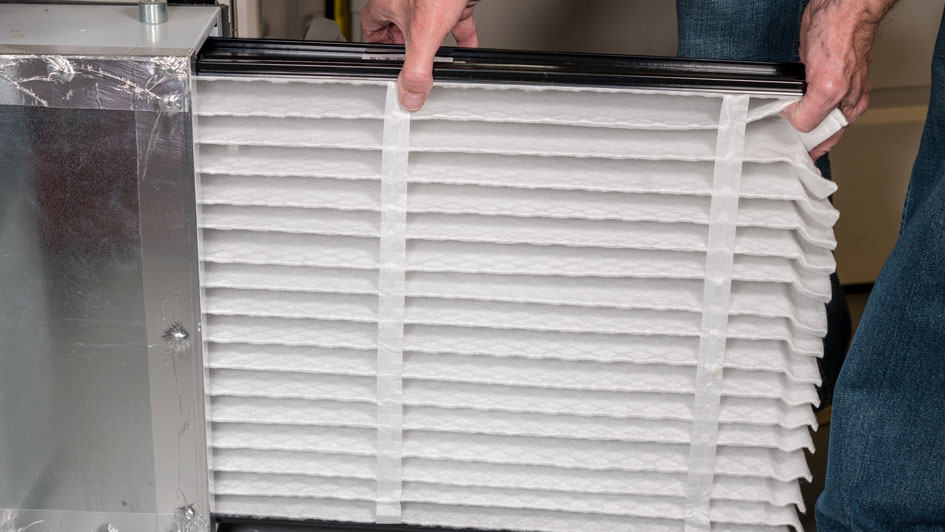
Picking out the right furnace filter and changing it when it becomes dirty is as important to your HVAC system as changing the oil is to your car. Each plays a crucial function in keeping its system working safely, efficiently and for a long time.
A clogged furnace filter loses its effectiveness, allowing potentially harmful particles to circulate through your home. It also limits airflow, which can damage your furnace and reduce its life span.
Ensuring your furnace uses a clean filter that is ideal for your needs is not just about keeping your furnace running efficiently. It’s also about creating good indoor air quality for your household.
Your health is important to the heating and cooling specialists at Temperature Doctors Heating & Cooling. We've long been dedicated to bettering indoor air quality in Rockford. Here, we’ve answered frequent questions about HVAC filters, including that particularly tricky question of what direction do you point a filter in your furnace or air conditioner?
How Often to Replace the Air Filter in a Furnace
It is important to replace dirty air filters in a furnace or air conditioner regularly. Soiled filters cause the system to worker harder than it should because it takes extra work to pull air through the plugged-up filter.
Officials recommend examining your furnace filter monthly and replacing it if it’s dirty. You’ll know if the filter needs to be changed because it will filled with dirt or dust. Those who have pets will very likely want to replace their furnace air filter more often, because a quality air filter will trap pet hair circulating in a home.
How to Find the Furnace's Air Filter
In general, a furnace air filter is commonly found in the return air duct or blower compartment before the return air reaches the furnace. This ensures air flowing into the system is filtered before it passes through the furnace components and is heated.
Depending on the type of furnace, the filter may be positioned on the right, left, bottom or in some cases, within the furnace. It's usually housed in a slot, frame or cabinet for easy access and replacement. Always refer to your furnace's owner manual for important information regarding filter location of your particular brand and model of furnace.
Is My Furnace Filter Just a Type of Air Filter?
The easy answer is, yes. In HVAC, a furnace filter and an air filter or air conditioning filter are basically the same thing. While people may call them different things based on the current season— hot or cold—they are all filters that clean the air in your home.
They each remove dust, allergens, bacteria and other contaminants from the air that is drawn into the furnace and air conditioning system, ensuring the air distributed throughout your home is clean and safe.
What Are MERV Ratings and What MERV Rating Should I Have?
Once you locate your old furnace filter and determine when it should be changed, it’s time to choose a replacement. That means picking the level of filtration that you need. One approach to this is by selecting an appropriate MERV rating for your needs.
MERV is an abbreviation for Minimum Efficiency Reporting Values. The MERV rating measures the effectiveness of air filters at trapping airborne contaminants. The rating scale ranges from 1 to 20, with greater numbers indicating a greater ability to filter smaller particles.
Experts say a filter with a MERV rating between 8 and 13 offers an appropriate balance between having adequate indoor air quality without needlessly restricting airflow. However, people with specific health conditions could need a a higher MERV rating.
Which Way to Put the Air Filter in a Furnace or Air Conditioning System
Putting an air filter in a furnace or air conditioner properly is important for the efficient operation of the system. Air filters are designed to be installed in a particular direction, indicated by an arrow located on the side of the filter frame. The filter should be placed in the unit with this arrow pointing at the furnace or air conditioning unit, which is the direction of the airflow. If you're doubtful about the airflow direction, try to remember that air always moves from the return duct to the heat or cooling source. Therefore, make sure the arrow points toward the furnace or AC.
Many people struggle with which direction to point their system's air filter. To help remember, consider snapping a quick photo with your mobile phone after the filter has been properly installed by a professional. Or, you also could ask a technician to use a marker to write on the outside of your furnace which direction the filter should go. A great time to inquire about this is during a scheduled furnace maintenance appointment.
Changing Your Furnace's Air Filter
Changing the filter on your furnace or air conditioning system is a quick and easy process. Here is a step-by-step breakdown of how to take out a dirty air filter and replace it with a new one:
- Turn off your furnace: Make a point to switch off your furnace before starting up the process.
- Look for the furnace filter: Typically, the filter is located within the furnace or in the air return vent. Make a mental note or write down which direction the arrow points on the filter, because you’ll want the arrow on the replacement filter to point in the same direction.
- Slide out the old filter: Be careful not to knock out any dust or particles.
- Document the date: Write down the date you replaced the filter on the new filter's frame. This will help you keep track of when it's time for the next change.
- Insert new filter: Put in the new filter with the arrow pointing in the direction of the furnace, which is the direction of airflow and should be the same direction the arrow pointed on your last filter.
- Secure the filter: Make sure the new filter fits nicely and close any latches or clips that hold it in the compartment.
- Turn on your furnace: Once the new filter is completely installed, you can turn your furnace back on.
Can a Dirty Air Filter Damage My Furnace?
The shortest answer is, yes, a dirty air filter can cause a furnace to cease working or decrease its lifespan. Changing your furnace or air conditioner filter is one of the best things you can do to keep your system running effectively.
